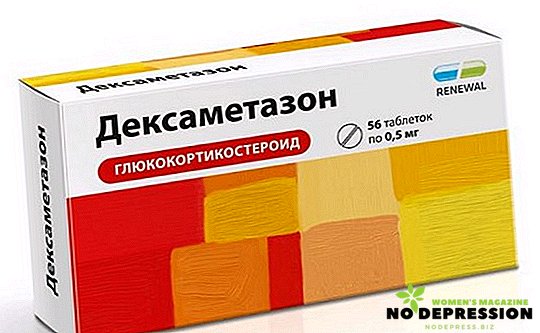Glucocorticoids are almost universal drugs, because they have found their use in the treatment of almost all diseases. Dexamethasone is one of the most commonly used drugs based on them. Despite the wide range of indications and the large number of therapeutic effects, it is dangerous to take it yourself, without the doctor's control. Consider the basic properties, the pharmacokinetics of the drug, as well as when it should be prescribed, and when not.

Pharmacological properties
Dexamethasone refers to glucocorticoid drugs. Get it synthetically. The basis is prednisolone containing a fluorine atom, as well as a methyl group (methylated fluoroprednisolone).
The drug, like hormones synthesized in the human body by the cells of the adrenal cortex, can only bind to the receptor apparatus of the cytoplasm of various cells.
 It is this mechanism that provides numerous pharmacological effects:
It is this mechanism that provides numerous pharmacological effects:
- Antiallergic (effective in all types of hypersensitivity).
- Immunosuppressive (inhibits the body's defenses).
- Anti-inflammatory.
- Bronchodilatory.
The drug can be used both locally and systemically. The latter option is used more often. Once in the bloodstream, Dexamethasone interacts with a transport protein (of albumin nature) called transcortin. It helps to communicate with the cell membranes, and then penetrate into the cytoplasmic space. The result is the activation of new proteins, receptors and enzymes to participate in virtually all types of metabolism: carbohydrate, protein, fat.
In the liver, Dexamethasone undergoes chemical transformations, resulting in the formation of inactive compounds. The excretion is carried out by the urinary system, and only a small proportion is excreted by the mammary glands during lactation in women.
What helps Dexamethasone
The spectrum of diseases for which the described drug is effective is very wide. First of all, it includes endocrinological diseases. Indeed, by nature, Dexamethasone is a synthetic analogue of corticoid hormones. Therefore, indications for the appointment are primarily diseases of the adrenal glands or the hypothalamic-pituitary system:
- congenital hypoplasia of the adrenal cortex;
- acute adrenal insufficiency;
- subacute inflammation of the thyroid tissue;
- primary or secondary decrease in adrenal cortex function.
 The second important group of diseases is associated with obstruction (marked narrowing) of the bronchi. According to the frequency of appointment in the hospital it is during bronchospasm that Dexamethasone or its analogues are prescribed. What are these diseases?
The second important group of diseases is associated with obstruction (marked narrowing) of the bronchi. According to the frequency of appointment in the hospital it is during bronchospasm that Dexamethasone or its analogues are prescribed. What are these diseases?
- Bronchial asthma during exacerbation.
- Asthmatic status, in which the appointment of Dexamethasone - the "gold" standard of treatment.
- Exacerbation of chronic obstructive pulmonary disease.
- Bronchitis with marked bronchospasm.
Dexamethasone is used in the basic therapy of many rheumatological diseases. With exacerbation of articular syndrome or other systemic manifestations, the dosage of the drug is increased compared with the constantly taken. The effect is associated with pronounced immunosuppression (suppression of the activity of immune cells).
Dexamethasone is prescribed for the following rheumatic diseases:
- Gout is in the acute stage.
- Pronounced synovitis.
- Rheumatoid arthritis.
- Inflammation of the joints.
- Lupus arthritis.
- Psoriatic arthropathy.
- Ankylosing spondylitis or ankylosing spondylitis.
Allergic diseases and reactions are conditions that often require dexamethasone. Among them, angioedema, allergic dermatitis, rhinitis, rhinoconjunctivitis, pollinosis. An emergency condition, such as anaphylactic shock, developing with lightning speed in the form of a hyperergic reaction, by standards, requires an intravenous or intravenous drip infusion of Dexamethasone.
It is worth saying that in the ambulance kits there is necessarily a described drug, because it quickly realizes the desired effect. When rendering urgent measures it is very important, because every minute counts. Dexamethasone is used for all types of shock: burn, pain, post-traumatic, metabolic, postoperative.
In dermatological practice, corticoids are used to relieve inflammation. They are applicable for the treatment of lupus, scleroderma, psoriatic eruptions, dermatitis of various nature, including contact. Absorption or antisclerosis effect can be achieved in the treatment of keloid scars.
Forms of release, composition, instructions for use
Dexamethasone is administered topically in the form of eye drops and systemically in the form of tablets and injection solution. The composition differs in the concentration of the active compound (methylated fluoroprednisolone) and auxiliary compounds.
Application solution for pricks
 The active base is the sodium phosphate salt of dexamethasone. 1 ampoule contains 2 milliliters of the drug. Each milliliter is dissolved 4 mg of active ingredient. Thus, one ampoule contains 8 mg of Dexamethasone sodium phosphate.
The active base is the sodium phosphate salt of dexamethasone. 1 ampoule contains 2 milliliters of the drug. Each milliliter is dissolved 4 mg of active ingredient. Thus, one ampoule contains 8 mg of Dexamethasone sodium phosphate.
For injection, the drug is diluted in saline sodium chloride or dextrose. Perhaps intramuscular and intravenous administration.
Doses of the drug
For the treatment of bronchial obstruction, the average dosage of the drug is 8 mg. In severe bronchospasm, the dose is increased to 12 mg.
Severe conditions, such as shock, asthmatic status, involve the use of a maximum single dose of 20 mg. During the day, the drug can be used 3-4 times. Therefore, the maximum daily dose is 80 mg.
Cancellation of treatment should be smooth, gradual. Every two to three days, the amount is reduced by 2–4 mg, either until complete withdrawal, or to a maintenance dose (4–8 mg).
Dexamethasone for children
Despite the low mineralocorticoid activity, the drug can affect the electrolyte metabolism in childhood. This is what the doctor fears when prescribing Dexamethasone.
Dosages differ from doses for adults, calculated based on body weight. Until the age of 12, the drug is treated with extreme caution and is prescribed only in situations where its reception is justified.
Dexamethasone tablets
The active compound content is 0.5 milligram. The average dosage can reach 30 mg. Therefore, the number of tablets in the treatment is frighteningly large.
This is the main drawback of the pill form. Among the auxiliary compounds in the tablet contains lactose. Allergic and other undesirable reactions may occur to this component.
Dexamethasone Eye Drops

Release form - dropper bottles. The volume of the drug is 5 milliliters. The active compound is sodium dexamethasone phosphate. This salt is dissolved in water for injection. The role of the buffer compound is edetate disodium. Boric acid is also among the excipients.
The duration of dexamethasone eye drops is 8 hours. That is, during the day you need to bury the drug at least 3 times. The course of treatment is discussed with an ophthalmologist.
Dexamethasone use during pregnancy and lactation
Given that one of the ways of removing the drug is the mammary ducts of the mammary glands, during lactation, breastfeeding should be stopped. Hormone medication can lead to impaired homeostasis, delayed bone growth, and underdevelopment of the adrenal cortex.
Pregnancy is a vulnerable period for mother and fetus. The use of glucocorticoids is at greater risk for the fetus, as they easily penetrate through histohematogenous barriers, including the placenta. Therefore, in the first trimesters, the use of Dexamethasone is justified only if there are serious indications.
Analogs of the drug Dexamethasone
 From the group of steroids use a large number of medicines. They are chemical in structure, properties similar to Dexamethasone, therefore, are considered its analogues:
From the group of steroids use a large number of medicines. They are chemical in structure, properties similar to Dexamethasone, therefore, are considered its analogues:
- Triamcinolone;
- Budesonide;
- Prednisolone;
- Hydrocortisone;
- Dexon;
- Mometasone;
- Methylprednisolone;
- Alclomethasone;
- Betamethasone.
You need to choose based on the disease and doctor's recommendations.
Side effects
Long-term medication may cause problems with carbohydrate metabolism. Patients increase blood sugar levels. A condition called steroid diabetes occurs. Endocrinologist deals with the treatment.
 A common undesirable effect is cushing-type obesity. At the same time, the volume of fatty tissue on the extremities decreases, and in the region of the abdomen and face it increases markedly. The area of the face is deformed, becomes moonlike. Pink or purple stripes are formed on the skin. We are talking about strii, signaling a pronounced violation of protein metabolism.
A common undesirable effect is cushing-type obesity. At the same time, the volume of fatty tissue on the extremities decreases, and in the region of the abdomen and face it increases markedly. The area of the face is deformed, becomes moonlike. Pink or purple stripes are formed on the skin. We are talking about strii, signaling a pronounced violation of protein metabolism.
Extremely negative dexamethasone can affect the gastrointestinal tract. It weakens the protective properties of the mucous membranes, creating favorable conditions for the formation of erosions or ulcers. The ulcerogenic effect is manifested in the treatment of high doses without proper gastroprotection (use of omeprazole or other antisecretory agents).
Prolonged use of steroids causes heart irregularities. There is a separate disease - dyshormonal myocardial dystrophy. It implies a violation of the rhythm of the heart, increasing the size of its chambers, reducing pumping function with the formation of the phenomena of heart failure as a result of hormonal disruption in the body. Including when using hormonal drugs as a treatment.
In women, dexamethasone causes a loss of calcium, a decrease in bone strength. Therefore, osteoporosis occurs. This condition also develops with prolonged use of hormonal agents from the Dexamethasone group.
Contraindications
Given the side effects, you should keep in mind the condition in which the reception of Dexamethasone is extremely undesirable. Among the contraindications are diseases such as:
- Gastroesophageal reflux with erosions in the esophagus.
- Gastric ulcer, duodenal ulcer.
- Erosive gastritis in the acute stage.
- Ulcerative lesion of the intestinal mucosa.
- AIDS.
- Myocardial infarction, transferred recently.
- Diabetes.
- Hyperthyroidism.
- Acute infectious diseases without antibiotic therapy.
Before you prescribe Dexamethasone in the presence of the above diseases, the doctor must weigh the expected benefits and possible risks.












